Impact of Water–Cement Ratio on Concrete Mechanical Performance: Insights into Energy Evolution and Ultrasonic Wave Velocity
Abstract
:1. Introduction
2. Experimental Materials and Methods
2.1. Test Material
2.2. Test Scheme
2.2.1. Uniaxial Compression Test
- Clean the surface of the specimens and apply vaseline as a lubricant to the upper and lower ends to reduce frictional resistance and mitigate internal damage.
- Place the test specimen on the pressure machine and adjust it so that the bearing surface aligns with the center of the upper and lower pressure plates.
- Select the stress control loading method with an average loading rate of 1 kN/s.
- Initiate the test instrument to apply load until the specimen fails.
2.2.2. Ultrasonic Test
3. Analysis of Test Results
3.1. Stress–Strain Characteristic Analysis
3.2. Analysis of Energy Evolution Characteristics
3.2.1. Law of Energy Evolution
- (I)
- Pore Compaction Stage: At this stage, numerous initial pores exist within the concrete, and the energy input from the exterior is primarily used to compact these initial pores and microcracks. Most of the total external energy is transformed into dissipative energy generated by the compression of pores, making the dissipative energy greater than the elastic energy, as depicted in Figure 7.
- (II)
- Elastic Deformation Stage: During this stage, the concrete undergoes primarily elastic deformation with the input energy predominantly stored as elastic energy. The elastic energy typically maintains a constant growth rate. Crack development inside the concrete is minimal, and the frictional heat generated by fine particles under external forces results in a small amount of dissipative energy, which increases gradually but at a slow rate.
- (III)
- Plastic Stage: The elastic energy continues to increase albeit at a slower rate. Microcracks begin to develop, causing the concrete to behave more like a plastic material. With the appearance of cracks, the dissipative energy starts to increase significantly. However, at this point, the cracks do not fully penetrate the concrete, and it still functions as a relatively efficient energy storage material.
- (IV)
- Failure Stage: At this stage, a significant number of microcracks develop, leading to concrete damage. The elastic strain energy stored in the concrete is released, resulting in the formation of shear cracks. Consequently, the elastic potential energy curve starts to decrease, while the dissipative energy curve increases linearly.
- (V)
- Residual Strength Stage: After failure, as shear cracks penetrate and concrete fragments begin to spall, the specimen approaches its residual strength. The input total energy curve grows at a slower rate, eventually reaching zero growth. The dissipated energy curve gradually aligns with the total energy curve. Simultaneously, the elastic energy curve starts to decrease due to the progressive destruction of the concrete skeleton, gradually approaching zero as well.
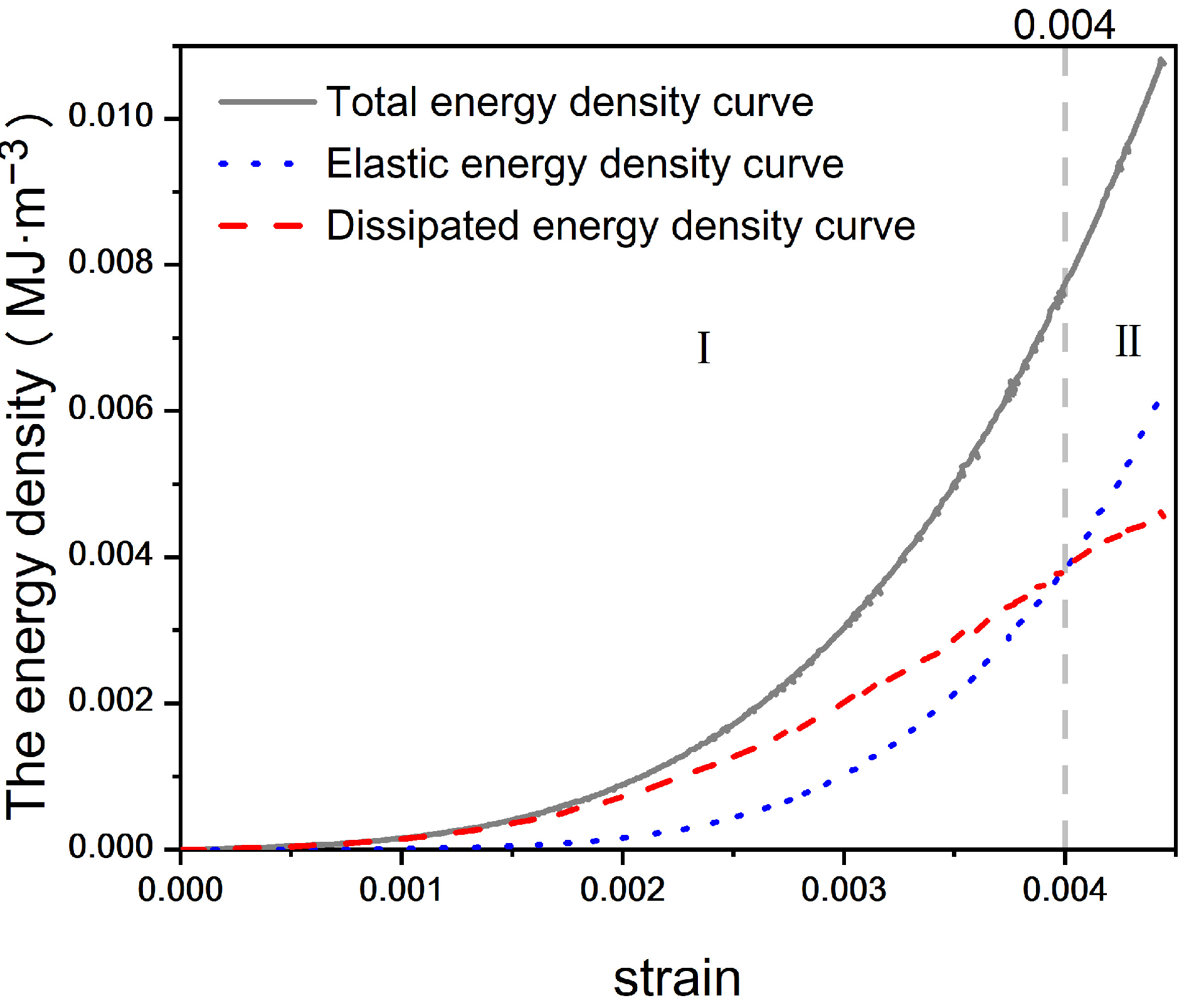
3.2.2. Energy Dissipation during the Pore Compaction Stage
3.3. Analysis and Verification of Ultrasonic Wave Velocity Change
3.3.1. Changes in Ultrasonic Wave Velocity
3.3.2. Comparative Verification of Pore Compaction Stages
3.4. Damage Characteristics in the Compaction Stage
3.4.1. Damage Characteristics Defined Based on Dissipated Energy
3.4.2. Damage Characteristics Defined Based on Ultrasonic Wave Velocity
3.5. Analysis of Damage Characteristics
3.5.1. Comparison of Damage Characteristics in the Compaction Stage
3.5.2. Whole Process Damage Variables Defined Based on Ultrasound
4. Discussion
5. Conclusions
- The characteristics of the pore compaction stage for concrete specimens with a high water–cement ratio are not pronounced. As the water–cement ratio increases, the fluidity of the cement paste increases, forming a cementitious layer that blocks some pores, reducing the initial porosity of the concrete specimens and resulting in decreased mechanical properties.
- In the pore compaction stage, the damage variable defined based on dissipated energy exhibits linear growth in the range of 0–0.025. The damage variable reflects the porosity of specimens with different water–cement ratios, and its growth trend reflects changes in porosity. Therefore, the damage variable defined based on dissipated energy can effectively reflect the damage characteristics of concrete specimens during the pore compaction stage.
- In the pore compaction stage, due to changes in the medium inside the pores, the ultrasonic wave undergoes diffraction, resulting in the fluctuation of the damage variable curve in the range of −0.06 to 0.04. Moreover, the damage to concrete is an irreversible process. Therefore, the damage variable defined based on ultrasound cannot accurately reflect the damage characteristics of the pore compaction stage.
- In the pre-peak stress stage, the damage variable defined based on ultrasound is in the range of −0.1 to 0.9, with an obvious threshold (the stress ratio is about 0.3). When the stress ratio is less than the threshold, the damage variable curve is wavy and has no obvious pattern; when the stress ratio is greater than the threshold, the damage variable increases rapidly, and its growth trend can reflect changes in the internal cracks within the specimens. Therefore, the damage variable defined based on ultrasound can reflect the overall mechanical properties of concrete.
Author Contributions
Funding
Institutional Review Board Statement
Informed Consent Statement
Data Availability Statement
Conflicts of Interest
References
- Sheng, F.; An, X.; Wang, Y.; Zhou, Y. Long-Term Monitoring of RC Beams under Different Partial Alkali–Silica Reactions: Experimental Results and Restraint Mechanisms. Buildings 2024, 14, 1991. [Google Scholar] [CrossRef]
- Golewski, G.L. Enhancement Fracture Behavior of Sustainable Cementitious Composites Using Synergy between Fly Ash (FA) and Nanosilica (NS) in the Assessment Based on Digital Image Processing Procedure. Theor. Appl. Fract. Mech. 2024, 131, 104442. [Google Scholar] [CrossRef]
- Liu, D.; Sui, W. Analysis of Influence of Water Cement Ratio on Performance of Pervious Concrete. Concrete 2020, 141–143. [Google Scholar] [CrossRef]
- Wang, Y.; Hu, H.X.; Wang, N.; Yan, C.; Chen, S.J.; Zhou, L. Experimental Study of Effects of Water-Cement Ratio on the Acoustic Emission Rate “a” Values in Concrete. Russ. J. Nondestruct. Test. 2017, 53, 620–635. [Google Scholar] [CrossRef]
- Choi, H.; Palacios, G.; Popovics, J.S.; Chao, S.-H. Monitoring Damage in Concrete Columns Using Ultrasonic Tomography. ACI Struct. J. 2018, 115, 545–558. [Google Scholar] [CrossRef]
- Chiriatti, L.; Francois, P.; Mercado-Mendoza, H.; Apedo, K.L.; Fond, C.; Feugeas, F. Monitoring of the Rebar-Concrete Bond Structural Health through Ultrasonic Measurements: Application to Recycled Aggregate Concrete. J. Civ. Struct. Health Monit. 2020, 10, 595–607. [Google Scholar] [CrossRef]
- Lorenzi, A.; Stein, K.; Reginatto, L.A.; da Silva Filho, L.C. Concrete Structures Monitoring Using Ultrasonic Tests. Rev. Constr. 2020, 19, 246–257. [Google Scholar] [CrossRef]
- Moradi-Marani, F.; Rivard, P.; Lamarche, C.P.; Kodjo, S.A. Evaluating the Damage in Reinforced Concrete Slabs under Bending Test with the Energy of Ultrasonic Waves. Constr. Build. Mater. 2014, 73, 663–673. [Google Scholar] [CrossRef]
- Ma, H.; Yu, H.F.; Li, C.; Tan, Y.S.; Cao, W.T.; Da, B. Freeze-Thaw Damage to High-Performance Concrete with Synthetic Fibre and Fly Ash Due to Ethylene Glycol Deicer. Constr. Build. Mater. 2018, 187, 197–204. [Google Scholar] [CrossRef]
- Kocáb, D.; Misák, P.; Jindrová, B.; Alexa, M.; Vymazal, T. Analysis of the Influence of transducer frequency on the ultrasonic measurement of concrete homogeneity. Spec. Concr. Compos. 2019, 22, 48–51. [Google Scholar] [CrossRef]
- Sharma, S.; Mukherjee, A. Monitoring Freshly Poured Concrete Using Ultrasonic Waves Guided through Reinforcing Bars. Cem. Concr. Compos. 2015, 55, 337–347. [Google Scholar] [CrossRef]
- Zhang, Y.; Ma, Z.; Zhi, X.; Chen, X.; Zhou, J.; Wei, L.; Liu, Z. Damage Characteristics and Constitutive Model of Phosphogypsum/Fly Ash/Slag Recycled Aggregate Concrete under Uniaxial Compression. Cem. Concr. Compos. 2023, 138, 104980. [Google Scholar] [CrossRef]
- Gao, H.; Hao, W.-x.; Bi, C.-k.; Sun, J.-h. Experimental Study on Characteristics of Acoustic Emission with Ultrasonic Wave of Concrete under Uniaxial Multilevel Loadings. J. Agric. Univ. Hebei 2017, 40, 119–123. [Google Scholar]
- Cai, Q.; Wang, T. Experimental Study on Testing Stress in Compressed Concrete by Ultrasonic Method. J. Highw. Transp. Res. Dev. 2023, 40, 50–57. [Google Scholar]
- Yin, Y.; Ren, Q.; Lei, S.; Zhou, J.; Xu, L.; Wang, T. Mesoscopic Crack Pattern Fractal Dimension-Based Concrete Damage Identification. Eng. Fract. Mech. 2024, 296, 109829. [Google Scholar] [CrossRef]
- Su, D.; Pang, J.; Han, C.; Huang, J.; Hu, X.; Shi, W. Influence of Basalt/Polypropylene Fiber on Permeability and Uniaxial Compressive Properties of Waste Tire Rubberized Concrete. Materials 2023, 16, 481. [Google Scholar] [CrossRef]
- Liang, D.; Qin, Y.; Kou, J.; Wang, Y.; Zhou, H.; Geng, K. Experimental Study on Energy Evolution of Concrete with Cold Joints under Uniaxial Compression Load. J. Drain. Irrig. Mach. Eng. 2023, 41, 481–486. [Google Scholar]
- Fursa, T.V.; Dann, D.D.; Petrov, M.V.; Lykov, A.E. Evaluation of Damage in Concrete Under Uniaxial Compression by Measuring Electric Response to Mechanical Impact. J. Nondestruct. Eval. 2017, 36, 30. [Google Scholar] [CrossRef]
- Kumar, S.; Mukhopadhyay, T.; Waseem, S.A.; Singh, B.; Iqbal, M.A. Effect of Platen Restraint on Stress–Strain Behavior of Concrete under Uniaxial Compression: A Comparative Study. Strength Mater. 2016, 48, 592–602. [Google Scholar] [CrossRef]
- Zhou, R.H.; Cheng, H.; Li, M.J.; Zhang, L.L.; Hong, R.B. Energy Evolution Analysis and Brittleness Evaluation of High-Strength Concrete Considering the Whole Failure Process. Crystals 2020, 10, 1099. [Google Scholar] [CrossRef]
- Zheng, Q.Q.; Hu, H.; Xu, Y.; Zhang, T. Damage Evolution Models of Static Pre-Loaded Concrete under Impact Load Based on the Weibull Distribution. Case Stud. Constr. Mater. 2022, 17, e01604. [Google Scholar] [CrossRef]
- Liu, W.Z.; Niu, S.W. Energy Evolution Properties and Strength Failure Criterion of Coal-Fired Slag Concrete Based on Energy Dissipation. Case Stud. Constr. Mater. 2022, 17, e01369. [Google Scholar] [CrossRef]
- Wang, H.; Dang, F.; Ren, J.; Li, Y.; Zhu, L. Experimental Research on the Energy Evolution of Concrete under Impact Loading. Materials 2023, 16, 5140. [Google Scholar] [CrossRef]
- Wardeh, M.A.; Toutanji, H.A. Parameter Estimation of an Anisotropic Damage Model for Concrete Using Genetic Algorithms. Int. J. Damage Mech. 2017, 26, 801–825. [Google Scholar] [CrossRef]
- Matallah, M.; Farah, M.; Grondin, F.; Loukili, A.; Roziere, E. Size-Independent Fracture Energy of Concrete at Very Early Ages by Inverse Analysis. Eng. Fract. Mech. 2013, 109, 1–16. [Google Scholar] [CrossRef]
- Kallel, H.; Carre, H.; Laborderie, C.; Masson, B.; Tran, N.C. Evolution of Mechanical Properties of Concrete with Temperature and Humidity at High Temperatures. Cem. Concr. Compos. 2018, 91, 59–66. [Google Scholar] [CrossRef]
- Qin, Y.; Men, B.; Liang, D.; Geng, K.Q.; Zhang, X.W.; Zhou, H.; Liu, R.F. Energy Evolution of Concrete with Cold Joint under the Action of Sulfate Dry-Wet Cycles with Loading. J. Build. Eng. 2023, 68, 106098. [Google Scholar] [CrossRef]
- Zhu, T.; Huang, F.; Liu, X.C. The Microscopic Failure Mechanism and Energy Evolution Law of Foamed Concrete under Uniaxial Compression. Mater. Lett. 2023, 352, 135196. [Google Scholar] [CrossRef]
- Gao, X.C.; Liu, S.; Zhao, C.; Yin, J.H.; Fan, K. Damage Evolution Characteristics of Back-Filling Concrete in Gob-Side Entry Retaining Subjected to Cyclical Loading. Materials 2022, 15, 5772. [Google Scholar] [CrossRef]
- DLT5330-2015; Regulations for the Design of Hydraulic Concrete Mix Ratio. China Electric Power Press: Beijing, China, 2015.
- GB/T 50081-2019; Standard for Test Methods of Physical and Mechanical Properties of Concrete. China Architecture Publishing Media Co., Ltd.: Beijing, China, 2019.
- Men, B.; Qin, Y.; Kou, J.; Dang, F.; Liang, D.; Shi, L.; Zhou, H. Energy Evolution of Concrete with Cold Joints under Sulfate Admixture Wet-Dry Cycling. J. Hydroelectr. Eng. 2022, 41, 38–49. [Google Scholar]
- Xu, Y.; Liu, J.; Yang, R.; Ding, J.; Gu, K. Mechanical Properties and Energy Evolution of Ultra High Strength Rubber Concrete. Jianzhu Cailiao Xuebao/J. Build. Mater. 2023, 26, 612–622. [Google Scholar]
- Yang, Y.; Ju, Y.; Chen, J.; Gao, F. Cracks Development Features and Energy Mechanism of Dense Sandstone Subjected to Triaxial Stress. Chin. J. Rock Mech. Eng. 2014, 33, 691–698. [Google Scholar]
- Yan, W.; Lu, G.; Jie, C.S.; Ting, Z.T.; Li, Z. Identification of the Damage Degree of Concrete with Different Water Cement Ratios Using the Acousto-Ultrasonic Technique. Mater. Test. 2017, 59, 909–915. [Google Scholar] [CrossRef]
- Du, E.; Zhang, J.; Yan, Y. Relation between Stress and Wave Velocity of Concrete Based on Ultrasonic Test. J. Hebei Univ. (Nat. Sci. Ed.) 2018, 38, 356–361. [Google Scholar]
- Xiang, J.; Song, H.; Leng, M.; Gui, F. Effect of Aggregate Size on Ultrasonic Pulse Velocity of Pervious Concrete. Concrete 2022, 106–111. [Google Scholar] [CrossRef]
- Long, Y.; Pan, C.; Guo, X.; Li, Y. Experimental Research on Dynamic Mechanical Properties of Rubber Concrete Subjected to Freeze-Thaw Cycles. Ind. Constr. 2022, 52, 163–170, 139. [Google Scholar]
- Zhao, M.; Xu, R. The Rock Damage and Strength Study Based on Ultrasonic Velocity. Chin. J. Geotech. Eng. 2000, 22, 720–722. [Google Scholar]
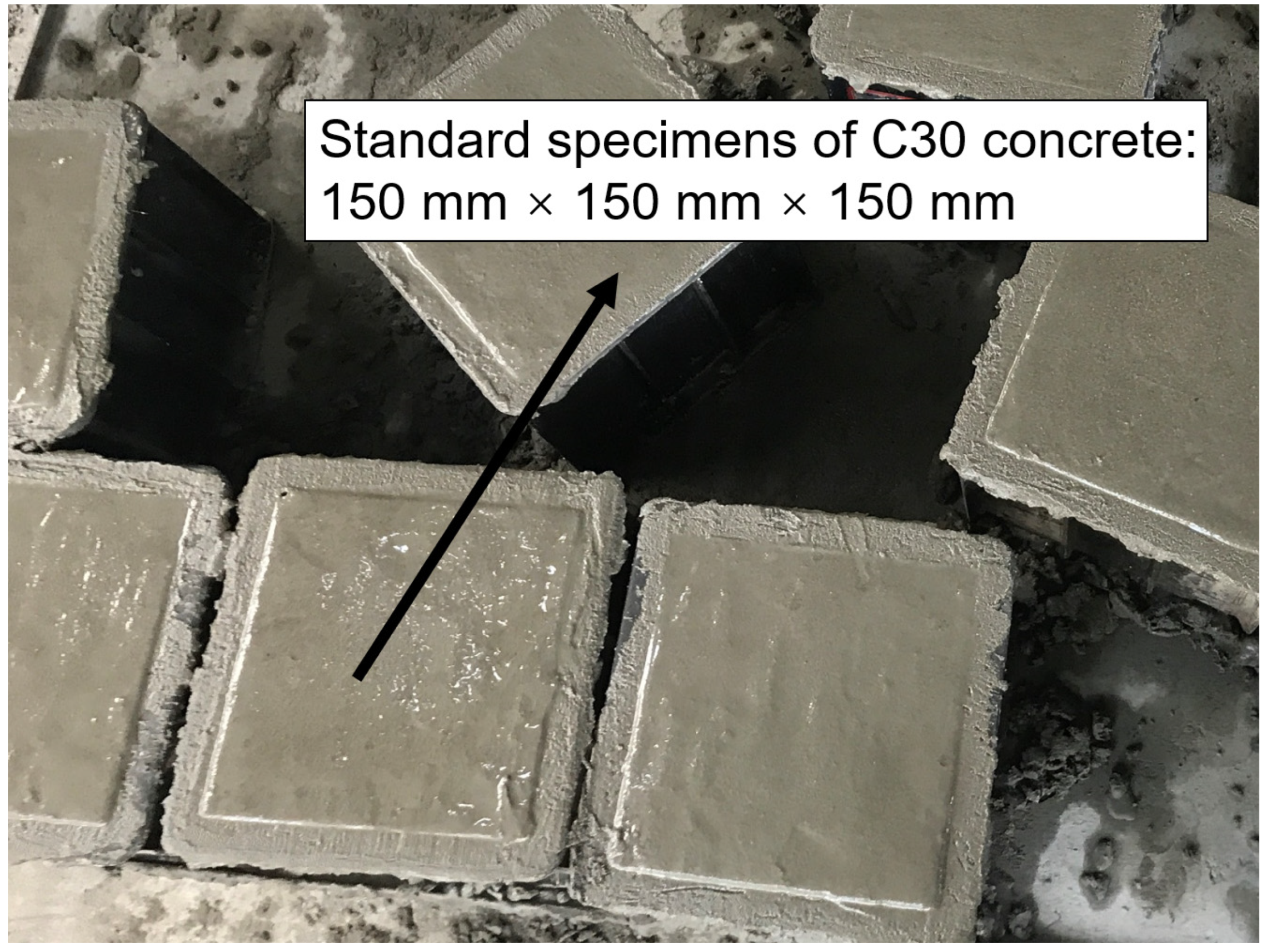
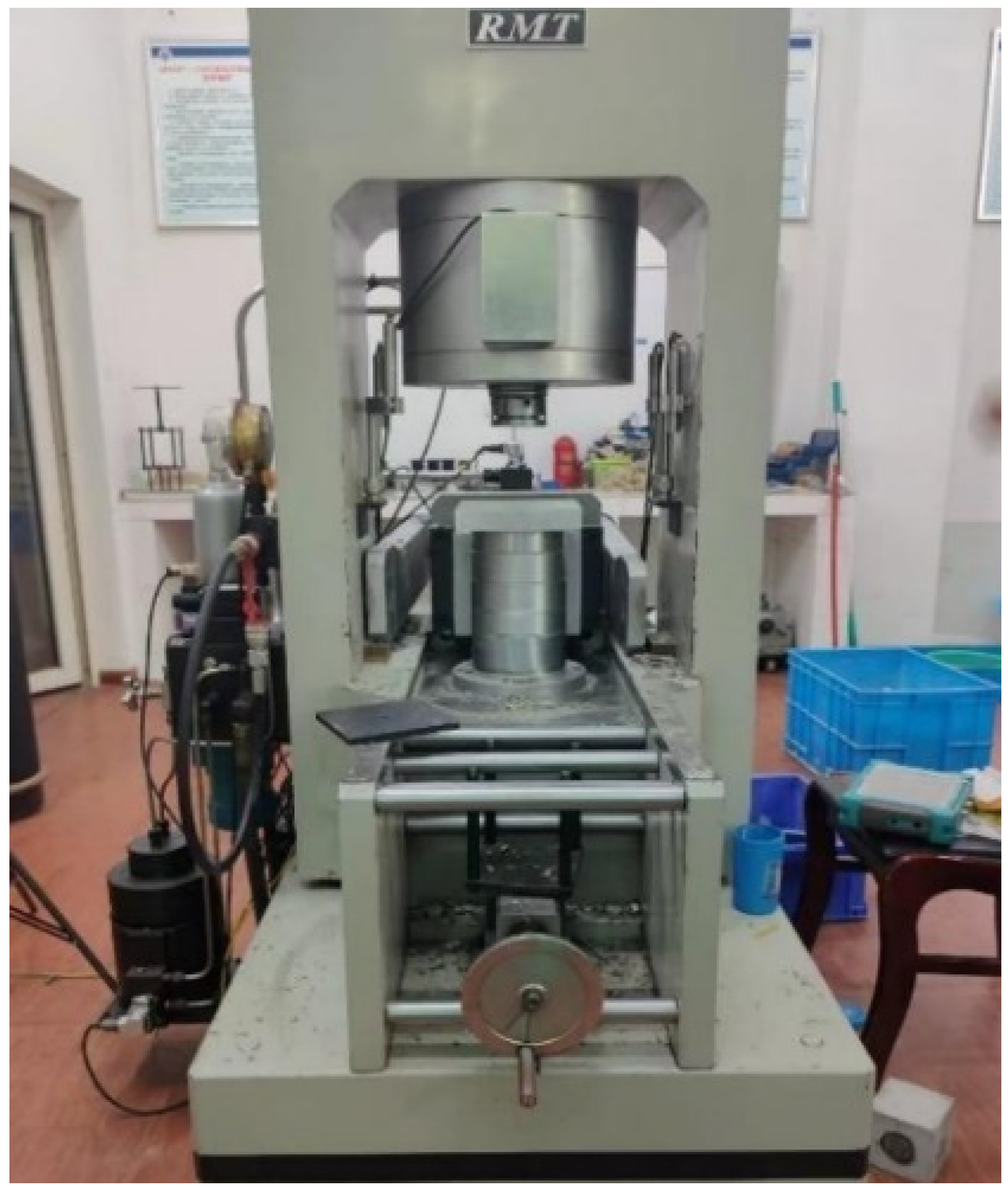
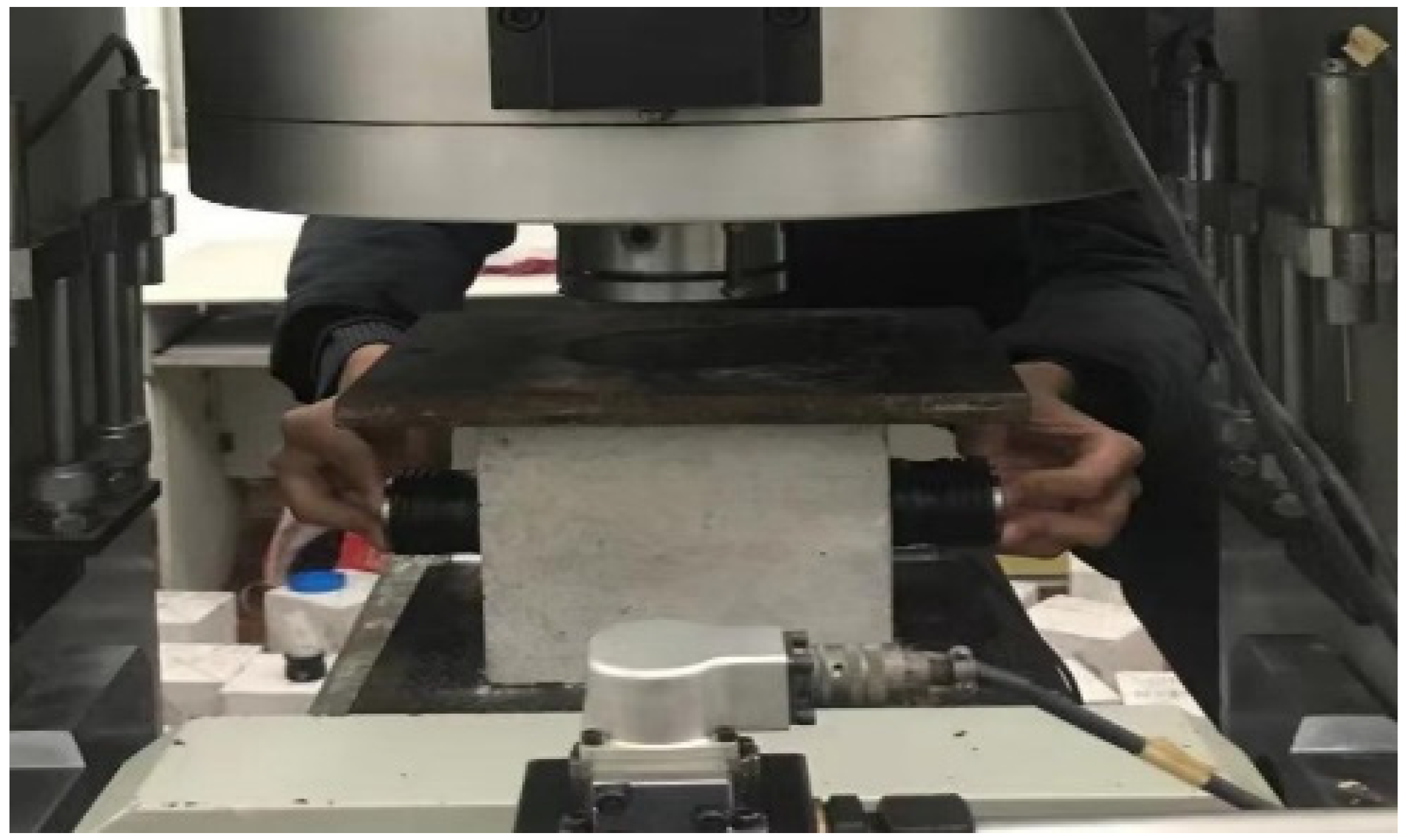


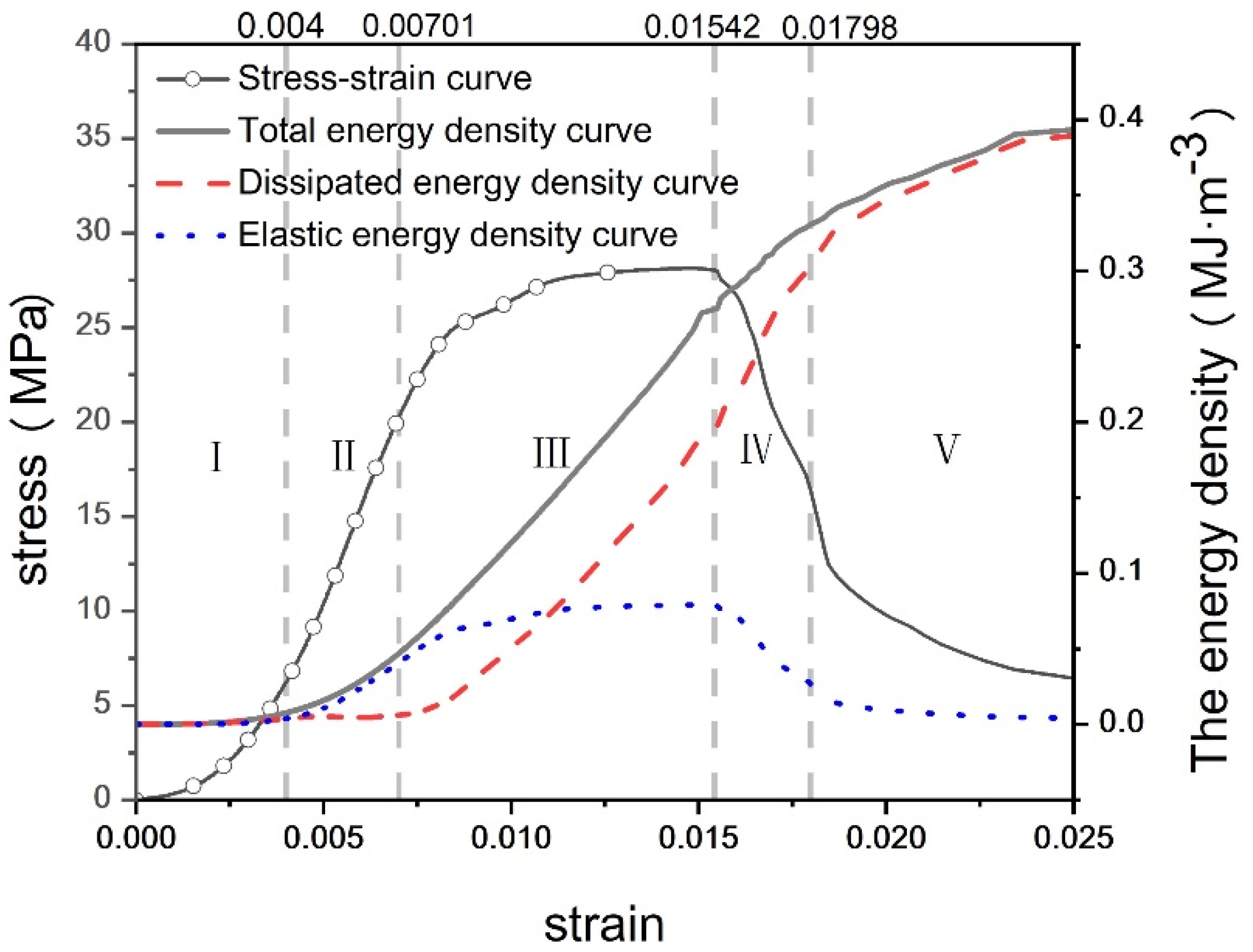




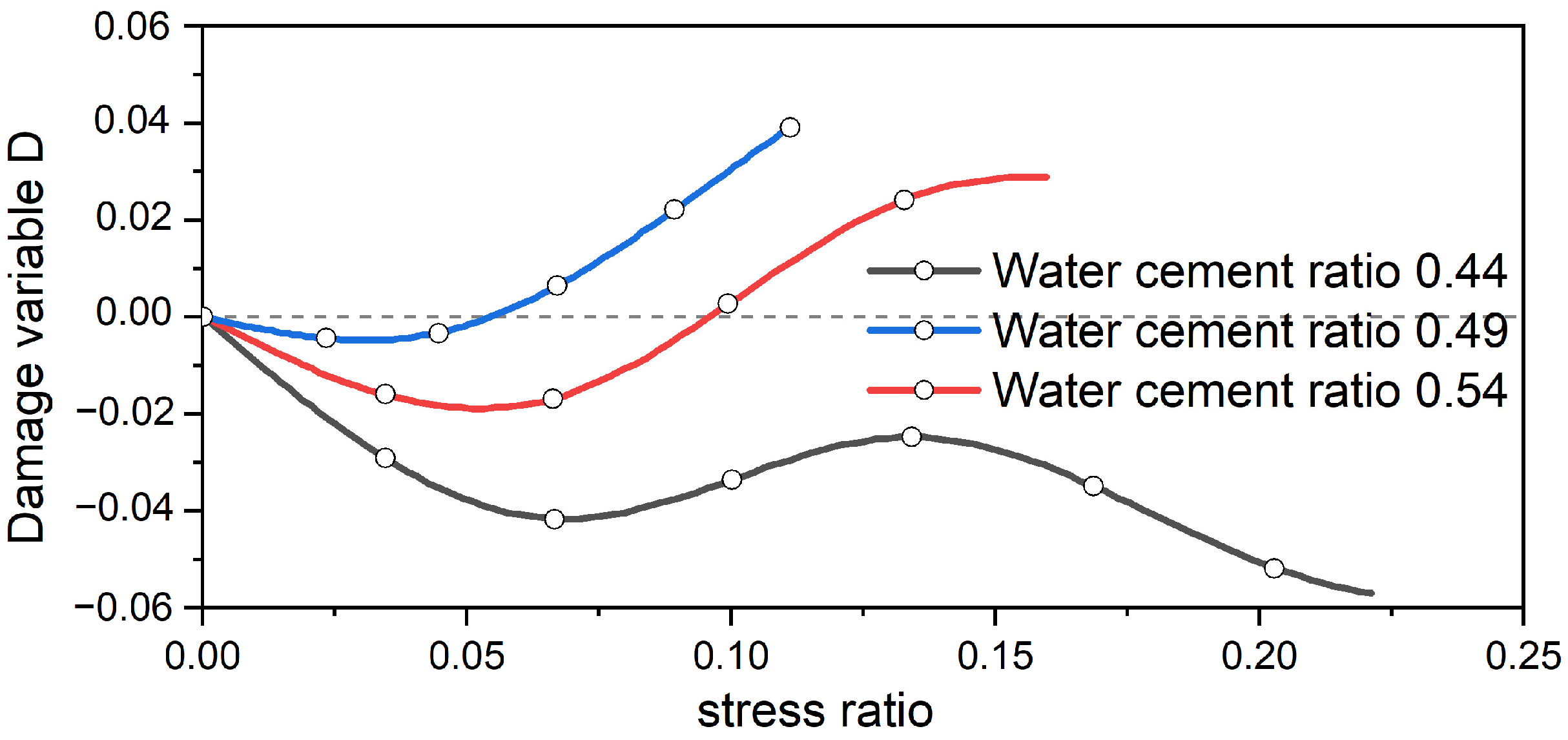
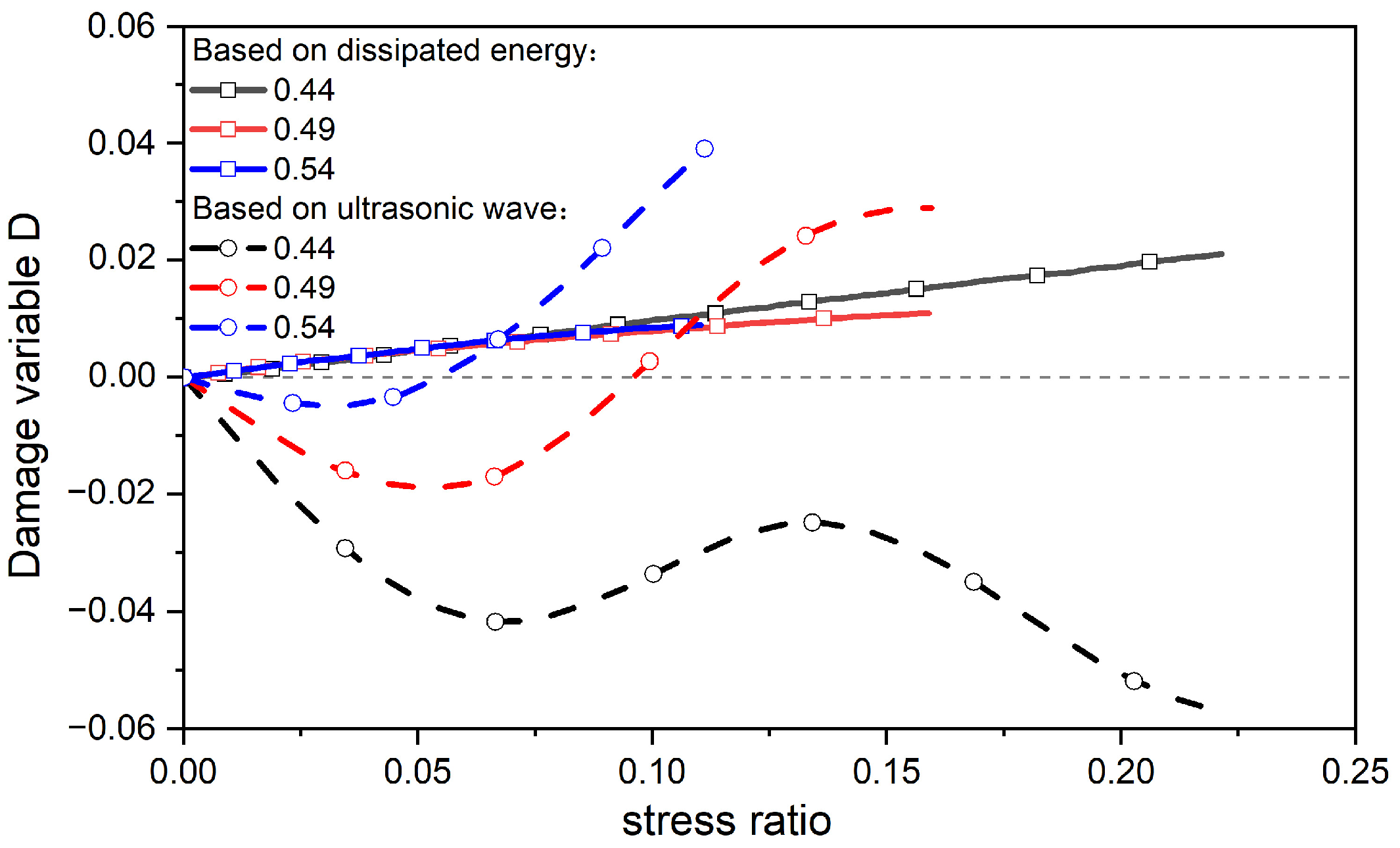
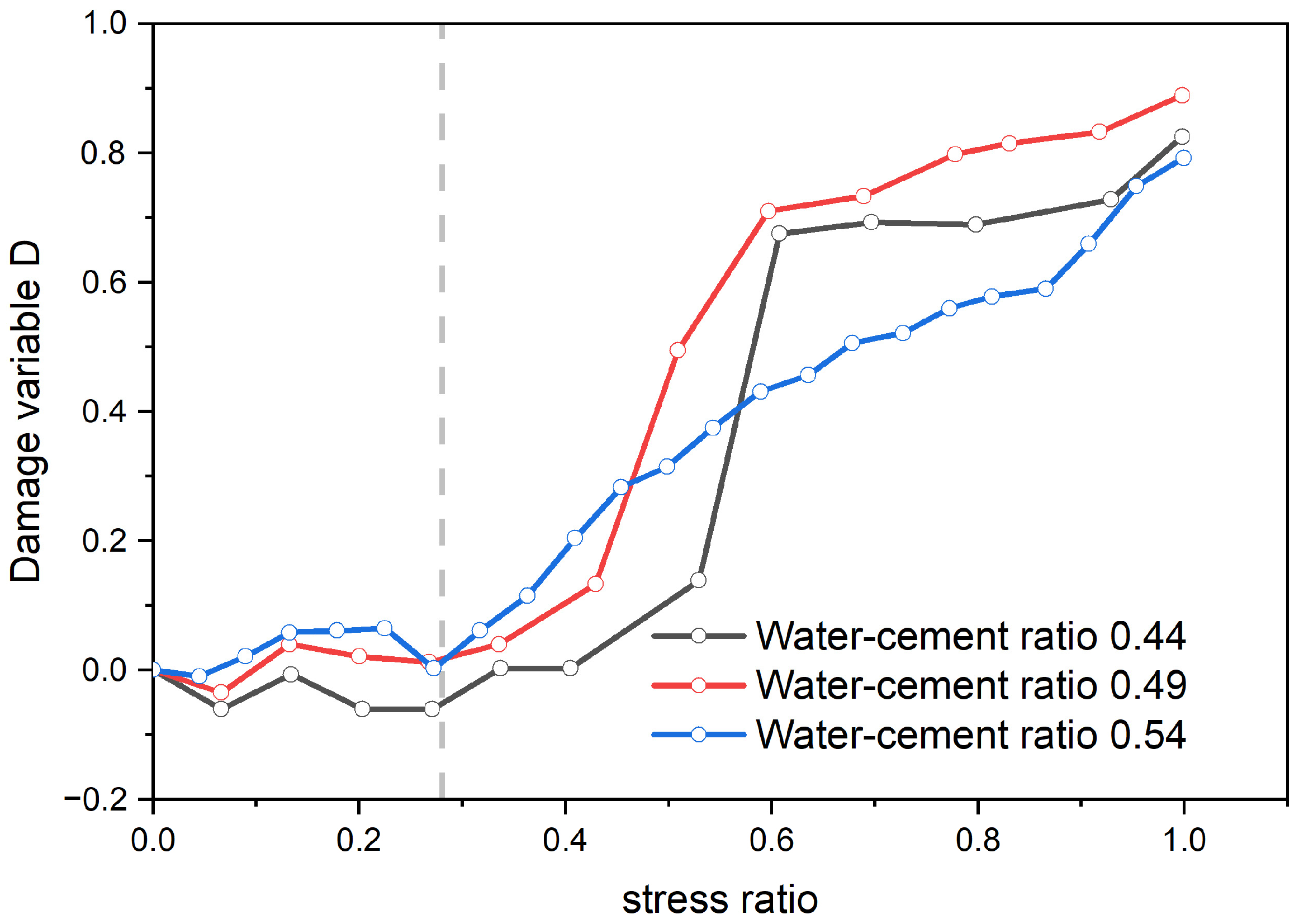
| Setting Time (Min) | Flexural Strength (Mpa) | Compressive Strength (Mpa) | |||
|---|---|---|---|---|---|
| Initial Setting Specimen | Final Setting Time | 3 Day | 28 Day | 3 Day | 28 Day |
| >150 | <250 | 4.5 | 7.5 | 22 | 46 |
| Water Absorption Rate (%) | Apparent Density (kg/m−3) | Bulk Density (kg/m−3) | Void Fraction (%) |
|---|---|---|---|
| 1.6 | 2700 | 14,600 | 38.9 |
| Water–Cement Ratio | Cement (kg/m3) | Water (kg/m3) | Gravel (kg/m3) | Sand (kg/m3) |
|---|---|---|---|---|
| 0.44 | 450 | 200 | 1200 | 650 |
| 0.49 | 400 | 195 | 1200 | 650 |
| 0.54 | 350 | 190 | 1200 | 650 |
Disclaimer/Publisher’s Note: The statements, opinions and data contained in all publications are solely those of the individual author(s) and contributor(s) and not of MDPI and/or the editor(s). MDPI and/or the editor(s) disclaim responsibility for any injury to people or property resulting from any ideas, methods, instructions or products referred to in the content. |
© 2024 by the authors. Licensee MDPI, Basel, Switzerland. This article is an open access article distributed under the terms and conditions of the Creative Commons Attribution (CC BY) license (https://creativecommons.org/licenses/by/4.0/).
Share and Cite
Lin, J.; Tian, B.; Liang, Z.; Hu, E.; Liu, Z.; Wang, K.; Sang, T. Impact of Water–Cement Ratio on Concrete Mechanical Performance: Insights into Energy Evolution and Ultrasonic Wave Velocity. Materials 2024, 17, 3651. https://doi.org/10.3390/ma17153651
Lin J, Tian B, Liang Z, Hu E, Liu Z, Wang K, Sang T. Impact of Water–Cement Ratio on Concrete Mechanical Performance: Insights into Energy Evolution and Ultrasonic Wave Velocity. Materials. 2024; 17(15):3651. https://doi.org/10.3390/ma17153651
Chicago/Turabian StyleLin, Junzhi, Bincheng Tian, Zelong Liang, Enpeng Hu, Zhaocun Liu, Kui Wang, and Tao Sang. 2024. "Impact of Water–Cement Ratio on Concrete Mechanical Performance: Insights into Energy Evolution and Ultrasonic Wave Velocity" Materials 17, no. 15: 3651. https://doi.org/10.3390/ma17153651






